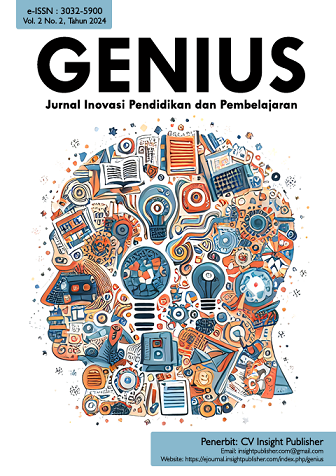The Influence of the Cooperative Learning Model on the Problem Solving Abilities and Mathematical Communication Abilities of Class VIII Students of Enrekang Regency Public Middle Schools
Main Article Content
Abstract
This study aims to determine the effect of: (1) a description of the problem-solving abilities of class VIII students who are taught using the cooperative learning model type two stay two stray or numbered heads together on the Pythagorean theorem and circle material, (2) description of the mathematical communication skills of class VIII students who are taught using the cooperative learning model type two stay two stray or numbered heads together on the Pythagorean theorem and circle material, (3) the difference in mathematical problem solving abilities of class VIII students who are taught using a two stay two stray cooperative learning model and those taught using a numbered heads together type cooperative model on the Teorema Phytagoras and Circle material, (4) differences mathematical communication skills of class VIII students who are taught using the cooperative learning model type two stay two stray with those taught using the cooperative model type numbered heads together on the Teorema Phytagoras and Circle material. This research is an experimental study with a quasi-experimental by factorial 2x2 design. The population in this study were all grade VIII students of the Enrekang Regency Junior High School with accreditation A consisting of 18 schools and the sample in this study was class VIII B SMP N 1 Baraka who was taught with the TSTS type cooperative learning model totaling 30 students and class VIII A SMP N 2 Anggeraja taught with the NHT type cooperative learning model totaling 30 students in the even semester of the 2019 school year. /2020, the determination of the sample is carried out using the cluster random sampling technique. The instruments in this study were (1) a test of problem-solving skills, (2) a test of mathematical communication skills, and (3) an observation sheet on the implementation of learning. The data analysis techniques used were descriptive analysis and inferential analysis using manova. The results of the study indicate that: (1) there is no significant difference in the mathematical problem solving abilities of students who follow the two stay two stray type of cooperative learning model and those who follow the numbered heads together type of cooperative learning model both on the Teorema Phytagoras material and on the Circle material; (2) there is no significant difference in the mathematical communication ability of students who follow the two stay two stray type of cooperative learning model and those who follow the numbered heads together type of cooperative learning model both on the Teorema Phytagoras material and on the Circle material.
Article Details

This work is licensed under a Creative Commons Attribution-ShareAlike 4.0 International License.
GENIUS: Jurnal Inovasi Pendidikan dan Pembelajaran is an Open Access Journal.
You are free to:
Share — copy and redistribute the material in any medium or format.
Adapt — remix, transform, and build upon the material for any purpose, even commercially.
References
Amin M., Nur Fitriani, Mardhiah, Damayanti Eka & Suharti. 2020. The Influence of Jigsaw-type Cooperative Learning Model on Students' Mathematics Learning Outcomes and Motivation. Jurnal Matematika Universitas Islam Negeri Alauddin Makassar, Indonesia. 3(3). 235-246.
Anggraeni Anggita Ayu, P. Veryliana & R. Fatkhu Ibnu. 2019. Pengaruh Model Pembelajaran Kooperatif Tipe Make A Match terhadap Motivasi dan Hasil Belajar Matematika. International Journal of Elementary Education. 3(2), 218-225.
Anita, Lie. (2010). Cooperative Learning: Mempraktikkan Cooperative Learning di Ruang-Ruang Kelas. Jakarta: Grasindo.
Hamzah, Ali. 2014. Evaluasi Pembelajaran Matematika. Depok : PT Raja Grafindo Persada.
Huda, Miftahul. (2013). Model-Model Pengajaran dan Pembelajaran. (Cetakan V).Yogyakarta: Pustaka Pelajar.
Isjoni. 2007. Pembelajaran Visioner. Jakarta: Pustaka Pelajar.
Maulana, Nikmatul., Rochmad & Soedjoko, Edy. 2013. Keefektifan Pembelajaran Model TAPPS Berbantuan Worksheet Terhadap Kemampuan Pemecahan Masalah Materi Lingkaran. Unnes Journal of Mathematics Education, 2(1), 32-39.
Murwatiningsih, E., Wahyudi, W., & Setiawan, Y. 2019. Efektivitas Model Think Talk Write dan Think Pair Share Terhadap Peningkatan Kemampuan Komunikasi Matematis Siswa Kelas 4 SD. Satya Widya: Jurnal Penelitian Pengembangan Kependidikan, 34(1),42-53.
Nuniek, Avianti. 2008. Mudah Belajar Matematika 2 untuk Kelas VIII Sekolah Menengah Pertama/Madrasah Tsanawiyah. Jakarta: Pusat Perbukuan Departemen Pendidikan Nasional.
Ontario Ministry of Education. 2005. The ontario Curriculum Grades 1-8 Mathematics (Rev. ed). Toronto: Queen’s Printer for Ontario.
Poewadarminta W.J.S. 1986. Kamus Besar Umum Indonesia. Jakarta: Balai Pustaka.
Qohar, A. 2011. Mathematical Communicationn: What and How to Develop it Mathematics Learning. This paper has been presented at Internasional Seminar and the Fourth National Conference on Mathematics Education 2011 “Building the Nation Character through Humanistic Mathematics Education”. In Departement of Mathematics Education, Yogyakarta Stata University.
Rahman, Risqi & Trisnawati, Winda. 2015. Perbedaan Kemampuan Pemecahan Masalah Matematik Siswa yang Mengikuti Pembelajaran dengan Metode Numbered Heads Together dan Metode Konvensional. Jurnal Ilmiah Program Studi Matematika STKIP Siliwangi Bandung, 4(1), 96-104.
Ruseffendi, E.T. 1991. Pengantar kepada Membantu Guru Mengembangkan Kompetensinya dalam Pengajaran Matematika untuk Meningkatkan CBSA. Bandung: Tarsito.
Sari, Arnida., & Azmi, Permata, Memen. 2018. Penerapan Model Kooperatif Tipe Two Stay Two Stray (TSTS) Terhadap Kemampuan Komunikasi Matematis. Jurnal Cendekia : Jurnal Pendidikan Matematika, 2(1), 164-171.
Soedjadi, R. 2000. Kiat Pendidikan Matematika di Sekolah, (Konstalasi Keadaan Masa Kini Menuju Masa Depan ). Jakarta: Direktorat Jendral Pendidikan Tinggi. Depdiknas.
Suhana, Cucu. 2014. Konsep Strategi Pembelajaran. Bandung: Refika Aditama.
Suprijono, Agus. 2009. Cooperative Learning.(Cetakan I). Surabaya: Pustaka Pelajar
Susanti, Dewi, Vera. (2014). Efektivitas Model Pembelajaran Portofolio dan Model Pembelajaran Kooperatif Think Pair and Share (TPS) Terhadap Prestasi Belajar Matematika Ditinjau Dari Kreativitas Siswa VII SMP Negeri 2 Kebonsari Tahun Ajaran 2011/2012. JIPM (Jurnal Ilmiah Pendidikan Matematika), 2(2), 1-5.
Tran Van Dat. 2014. The Effects of Cooperative Learning on The Academic Achievement And Knowledge Retention. International Journal of Higher Education, Vietnam: An Giang University. 3(2), 131-140.
Zulkarnain, Ihwan. 2015. Kemampuan Pemecahan Masalah dan Kemampuan Komunikasi Matematika Siswa. Jurnal Ilmiah Pendidikan MIPA, 5(1), 42-54.

